非限制性定语从句
- 格式:doc
- 大小:80.00 KB
- 文档页数:8

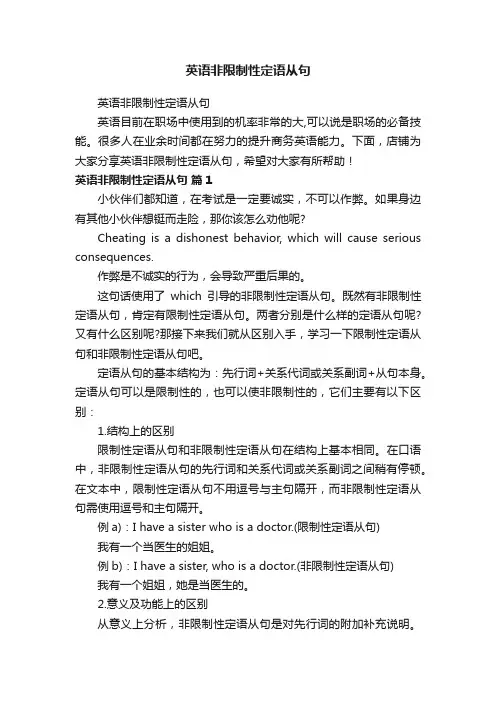
英语非限制性定语从句英语非限制性定语从句英语目前在职场中使用到的机率非常的大,可以说是职场的必备技能。
很多人在业余时间都在努力的提升商务英语能力。
下面,店铺为大家分享英语非限制性定语从句,希望对大家有所帮助!英语非限制性定语从句篇1小伙伴们都知道,在考试是一定要诚实,不可以作弊。
如果身边有其他小伙伴想铤而走险,那你该怎么劝他呢?Cheating is a dishonest behavior, which will cause serious consequences.作弊是不诚实的行为,会导致严重后果的。
这句话使用了which引导的非限制性定语从句。
既然有非限制性定语从句,肯定有限制性定语从句。
两者分别是什么样的定语从句呢?又有什么区别呢?那接下来我们就从区别入手,学习一下限制性定语从句和非限制性定语从句吧。
定语从句的基本结构为:先行词+关系代词或关系副词+从句本身。
定语从句可以是限制性的,也可以使非限制性的,它们主要有以下区别:1.结构上的区别限制性定语从句和非限制性定语从句在结构上基本相同。
在口语中,非限制性定语从句的先行词和关系代词或关系副词之间稍有停顿。
在文本中,限制性定语从句不用逗号与主句隔开,而非限制性定语从句需使用逗号和主句隔开。
例a):I have a sister who is a doctor.(限制性定语从句)我有一个当医生的姐姐。
例b):I have a sister, who is a doctor.(非限制性定语从句)我有一个姐姐,她是当医生的。
2.意义及功能上的区别从意义上分析,非限制性定语从句是对先行词的附加补充说明。
如果删去,不会影响主句意义的完整。
而限制性定语从句修饰和限制先行词,明确先行词内容,是先行词不可缺少的定语。
如果删去,会影响主句意义的完整。
例c):I have an elder brother who is a teacher.(限制性定语从句)我有一个当老师的哥哥。

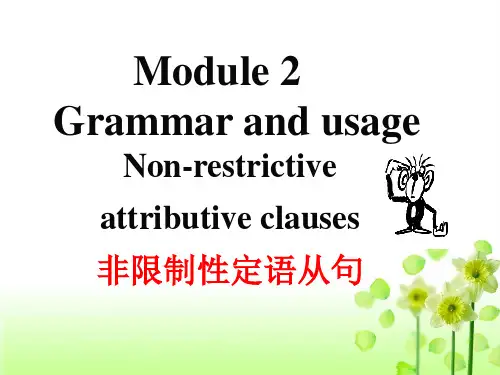

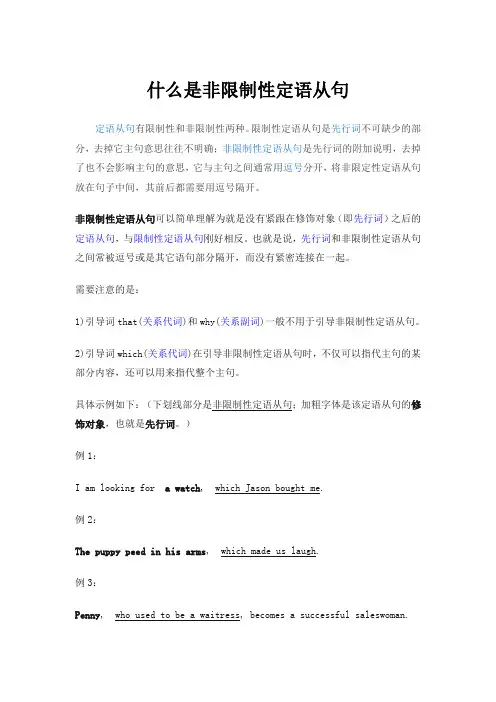
什么是非限制性定语从句定语从句有限制性和非限制性两种。
限制性定语从句是先行词不可缺少的部分,去掉它主句意思往往不明确;非限制性定语从句是先行词的附加说明,去掉了也不会影响主句的意思,它与主句之间通常用逗号分开,将非限定性定语从句放在句子中间,其前后都需要用逗号隔开。
非限制性定语从句可以简单理解为就是没有紧跟在修饰对象(即先行词)之后的定语从句,与限制性定语从句刚好相反。
也就是说,先行词和非限制性定语从句之间常被逗号或是其它语句部分隔开,而没有紧密连接在一起。
需要注意的是:1)引导词that(关系代词)和why(关系副词)一般不用于引导非限制性定语从句。
2)引导词which(关系代词)在引导非限制性定语从句时,不仅可以指代主句的某部分内容,还可以用来指代整个主句。
具体示例如下:(下划线部分是非限制性定语从句;加粗字体是该定语从句的修饰对象,也就是先行词。
)例1:I am looking for a watch, which Jason bought me.例2:The puppy peed in his arms, which made us laugh.例3:Penny, who used to be a waitress, becomes a successful saleswoman.例4:Many people witnessed the accident, some of whom called the police.例5:Jacob is the silent boy standing in the back, whose hair is black and straight.例6:He realized the days were all over when they could talk everything to each other.例7:She wandered in the school alone and aimlessly, where they last met.值得注意的是,由于定语从句的本质是形容词,通常只起到修饰作用,所以定语从句本身一般不会对主句的完整性产生任何影响。
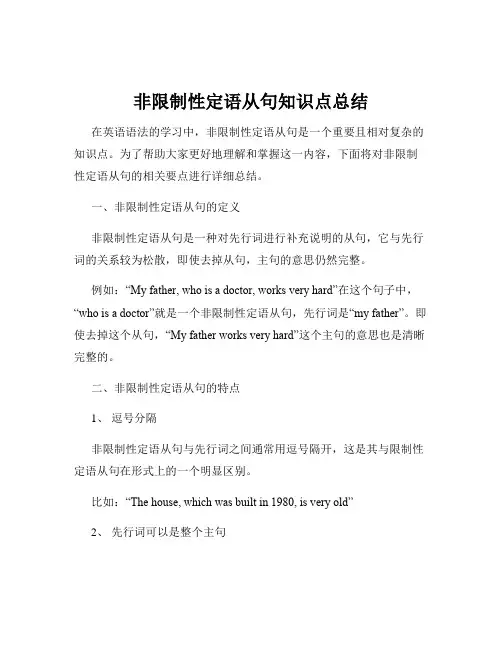
非限制性定语从句知识点总结在英语语法的学习中,非限制性定语从句是一个重要且相对复杂的知识点。
为了帮助大家更好地理解和掌握这一内容,下面将对非限制性定语从句的相关要点进行详细总结。
一、非限制性定语从句的定义非限制性定语从句是一种对先行词进行补充说明的从句,它与先行词的关系较为松散,即使去掉从句,主句的意思仍然完整。
例如:“My father, who is a doctor, works very hard”在这个句子中,“who is a doctor”就是一个非限制性定语从句,先行词是“my father”。
即使去掉这个从句,“My father works very hard”这个主句的意思也是清晰完整的。
二、非限制性定语从句的特点1、逗号分隔非限制性定语从句与先行词之间通常用逗号隔开,这是其与限制性定语从句在形式上的一个明显区别。
比如:“The house, which was built in 1980, is very old”2、先行词可以是整个主句非限制性定语从句的先行词不仅可以是一个名词或代词,还可以是整个主句。
例如:“He failed the exam, which made his parents very disappointed” 这里先行词就是“He failed the exam”整个句子。
3、关系词的使用(1)关系代词:which、who、whom、whose 等。
which 指代物,在从句中可作主语、宾语等。
who 指代人,在从句中作主语。
whom 指代人,在从句中作宾语。
whose 表示“……的”,在从句中作定语。
(2)关系副词:when、where 等。
when 指代时间,在从句中作时间状语。
where 指代地点,在从句中作地点状语。
需要注意的是,非限制性定语从句中不能使用 that 作为关系词。
三、非限制性定语从句中关系词的具体用法1、 which 的用法(1)which 可以指代主句中的某个名词,也可以指代整个主句。
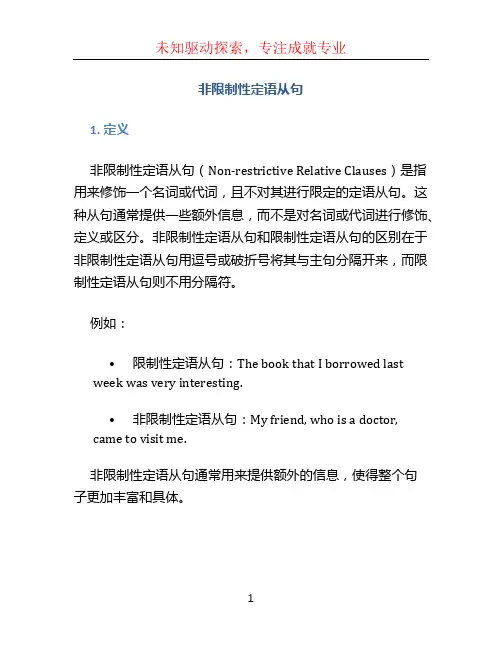
非限制性定语从句1. 定义非限制性定语从句(Non-restrictive Relative Clauses)是指用来修饰一个名词或代词,且不对其进行限定的定语从句。
这种从句通常提供一些额外信息,而不是对名词或代词进行修饰、定义或区分。
非限制性定语从句和限制性定语从句的区别在于非限制性定语从句用逗号或破折号将其与主句分隔开来,而限制性定语从句则不用分隔符。
例如:•限制性定语从句:The book that I borrowed last week was very interesting.•非限制性定语从句:My friend, who is a doctor, came to visit me.非限制性定语从句通常用来提供额外的信息,使得整个句子更加丰富和具体。
2. 结构非限制性定语从句的结构相对简单,通常由关系副词(如where, when, why)或关系代词(如who, whom, which)引导,并且使用逗号或破折号将其与主句分隔开来。
以下是一些常见的关系代词和关系副词:•关系代词:who, whom, whose, which, that•关系副词:where, when, why例如:•关系代词引导的非限制性定语从句:My brother, who is a teacher, lives in London.•关系副词引导的非限制性定语从句:I still remember the day, when we went to the beach.3. 示例以下是一些示例,以帮助读者更好地理解非限制性定语从句的用法和作用。
1.This is my father, who is an engineer.2.The house, which was built in the 19th century, is now a museum.3.She loves music, which is why she plays the piano every day.4.The dog, whose tail is wagging, seems very happy.5.Tom finally got the job, which he had been dreaming of.4. 注意事项在使用非限制性定语从句时,需要注意以下几点:•逗号或破折号:非限制性定语从句通常使用逗号或破折号与主句分隔开来,这有助于读者更好地理解句子的结构和意思。
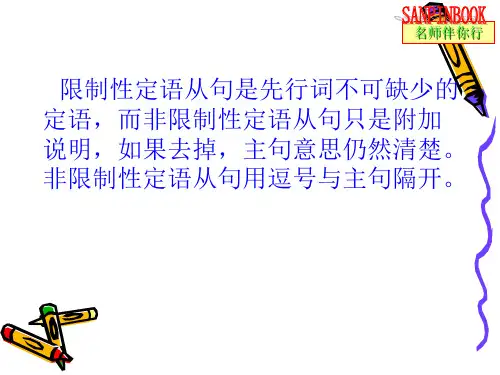

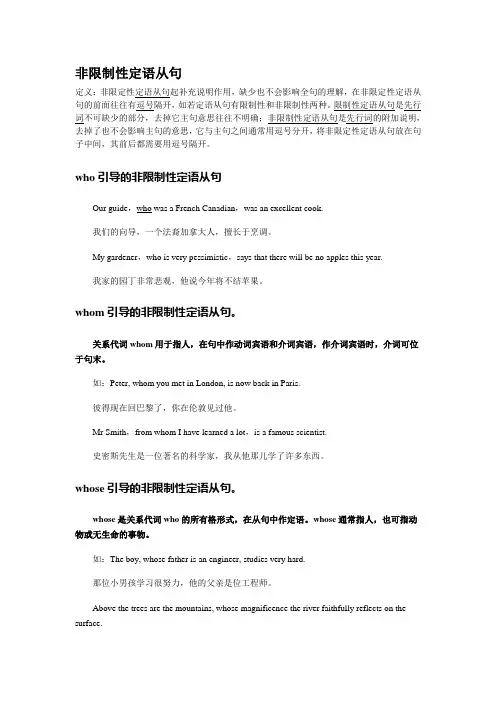
非限制性定语从句定义:非限定性定语从句起补充说明作用,缺少也不会影响全句的理解,在非限定性定语从句的前面往往有逗号隔开,如若定语从句有限制性和非限制性两种。
限制性定语从句是先行词不可缺少的部分,去掉它主句意思往往不明确;非限制性定语从句是先行词的附加说明,去掉了也不会影响主句的意思,它与主句之间通常用逗号分开,将非限定性定语从句放在句子中间,其前后都需要用逗号隔开。
who引导的非限制性定语从句Our guide,who was a French Canadian,was an excellent cook.我们的向导,一个法裔加拿大人,擅长于烹调。
My gardener,who is very pessimistic,says that there will be no apples this year.我家的园丁非常悲观,他说今年将不结苹果。
whom引导的非限制性定语从句。
关系代词whom用于指人,在句中作动词宾语和介词宾语,作介词宾语时,介词可位于句末。
如:Peter, whom you met in London, is now back in Paris.彼得现在回巴黎了,你在伦敦见过他。
Mr Smith,from whom I have learned a lot,is a famous scientist.史密斯先生是一位著名的科学家,我从他那儿学了许多东西。
whose引导的非限制性定语从句。
whose是关系代词who的所有格形式,在从句中作定语。
whose通常指人,也可指动物或无生命的事物。
如:The boy, whose father is an engineer, studies very hard.那位小男孩学习很努力,他的父亲是位工程师。
Above the trees are the mountains, whose magnificence the river faithfully reflects on the surface.在树林的高处是山,其壮丽的景色完全映照在河面上。
②引导非限定性定语从句的关系副词主要有:when,where限定性定语从句与非限定性定语从句的区别1.限定性定语从句: 从句不能省略,如果省略整个句子意思不完整。
非限定性定语从句: 从句可以省略,如果省略整个句子意思仍然完整。
2.限定性定语从句: 先行词可以用that 引导。
非限定性定语从句: 先行词不可以用that 引导。
3.限定性定语从句: 引导词有时可以省略。
非限定性定语从句:引导词不可以省略。
4.限定性定语从句:主句与从句不需要用逗号隔开。
非限定性定语从句:主句与从句需要用逗号隔开。
5.限定性定语从句: 从句只修饰先行词。
非限定性定语从句:从句既可以修饰先行词,也可以修饰整个句子或句子的一部分。
功能和形式方面的区别为什么说限定性定语从句与主句的关系很紧凑,对其先行词起限定、修饰的作用。
如果将其去掉,会影响句子意思的完整性;有时甚至于引起费解、误解。
例如:1.Rainforests are being cleared for valuable timber and other resources to speed up the economic growth of the nations in which they are located .为了加速他们各自所在国家的经济发展,热带雨林作为有价值的原木和其他资源正为人们所砍伐。
2.Ocean currents affect the climates of the lands near which they flow.洋流影响其流经的附近地区的气候。
3.They explained the reason to us why they had hated us before.他们向我们解释为什么他们不喜欢我们的原因。
非限定性定语从句在形式上就与主句很松散,它与主句之间有一个逗点","隔开;它对其先行词没有限定、修饰的作用,只起补充、说明的作用。
非限制性定语从句非限制性定语从句起补充说明作用,缺少也不会影响全句的理解。
在非限制性定语从句的前面往往有逗号隔开,如The house,which I bought last year,has a lovely garden. 我去年买的的房子带着个漂亮的花园。
This novel, which I have read three times, is very touching. 这本我已经读过三遍的小说很感人。
3. 非限定性定语从句可将整个主句作为先行词,对其进行修饰, 这时从句谓语动词要用第三人称单数,例如:He seems not to have grasped what I meant, which greatly upsets me.他似乎没抓住我的意思,这使我心烦。
Liquid water changes to vapor, which is called evaporation. 液态水变为蒸汽,这就叫做蒸发。
4. 有时as也可用作关系代词5. 在非限定性定语从句中,不能用于在从句中做主语(1)The boys who are playing football are from Class One. 在踢足球的男孩们是一班的。
(2)Yesterday I helped an old man who lost his way. 昨天,我帮助了一个迷路的老人。
限制性定语从句和非限制性定语从句的区别:上述定语从句都是我们已经学过的限制性定语从句。
所谓限制性定语从句,是指定语从句部分对先行词起限制、修饰的作用,关系代词有that, which, whom, who, whose以及关系副词when, where, why等,没有逗号把从句与先行词分开。
限制性定语从句是先行词不可缺少的部分,去掉它主句意思往往不明确。
Do you know the professor who is speaking at the meeting?你认识那个正在会上讲话的教授吗?Where is the book which I bought this morning?我今天上午买的书在哪儿呢?此外,还有一类非限制性定语从句,非限制性定语从句是先行词的附加说明,去掉了也不会影响主句的意思,它与主句之间通常用逗号分开。
什么是非限制性定语从句?非限制性定语从句是英语中的一种定语从句形式,用于为名词或代词提供额外的信息和描述,但不是必需的。
与限制性定语从句不同,非限制性定语从句通常用逗号或者括号将其与主句分开。
下面是关于非限制性定语从句的一些重要信息:1. 引导词的选择:非限制性定语从句通常由关系代词(who, whom, whose, which)或关系副词(when, where, why)引导。
引导词在从句中充当主语、宾语或者定语。
例如:- My brother, who is a doctor, lives in New York.(我的兄弟,他是一名医生,住在纽约。
)- The book, which I borrowed from the library, is very interesting.(我从图书馆借来的那本书非常有趣。
)2. 逗号的使用:非限制性定语从句通常用逗号将其与主句分开,以示从句与主句之间的区别。
逗号的使用不仅可以提供语法上的指示,还可以帮助读者理解从句是额外信息的一部分。
例如:- John, who is my best friend, is coming to visit me.(约翰,我的最好的朋友,要来看我了。
)- The company, which is located in London, has been in business for 20 years.(这家位于伦敦的公司已经经营了20年。
)3. 从句的位置:非限制性定语从句可以出现在句子的开头、中间或结尾,具体位置取决于句子的结构和意义。
例如:- My teacher, who is very knowledgeable, taught me a lot.(我的老师很有知识,教了我很多。
)- I visited the museum yesterday, which is located downtown.(昨天我参观了市区的博物馆。
非限制性定语从句非限制性定语从句,中文语法中常常使用到的一种修饰从句。
它的作用是对主句的某一成分进行进一步的补充说明或者限制。
与限制性定语从句不同的是,非限制性定语从句强调的是对主句内容的附加说明,而不是对其进行限制或者约束。
非限制性定语从句通常用来修饰某一名词、代词或者整个主句,并且常常使用逗号与主句分开。
它可以用来指明人或者事物的特点、属性、背景等信息。
以下是几个例子来阐述非限制性定语从句的应用:1. William Shakespeare, who is considered the greatest playwright in history, wrote many famous plays.(威廉·莎士比亚被认为是历史上最伟大的剧作家,他写了许多著名的戏剧。
)其中的“who is considered the greatest playwright in history”是对“William Shakespeare”进行进一步的补充说明。
2. The sun, which is the center of our solar system, provides light and heat to the Earth.(太阳是我们太阳系的中心,为地球提供光和热。
)这个例子中的“which is the center of our solar system”对“the sun”的属性进行了补充说明。
3. My friend Jane, who is a talented musician, will perform at the concert tonight.(我的朋友简是一位才华横溢的音乐家,她将在今晚的音乐会上表演。
)在这个例子中,非限制性定语从句“who is a talented musician”对“my friend Jane”进行了进一步的描述。
需要注意的是,在非限制性定语从句中,关系词通常可以省略。
Ⅰ. 非限制性定语从句我将永远不会忘记我第一次遇到你的那一天。
(when引导限制性定语从句)*They will set off for London next year, when they will have enough money.他们打算明年去伦敦, 届时钱也凑够了。
(when引导非限制性定语从句)*He has found the hammer that he was looking for.他找到了他正在寻找的那把锤子。
(that引导限制性定语从句)*A man who doesn’t want to learn from others can’t achieve much.一个不向别人学习的人是不能指望有多大成就的。
(who引导限制性定语从句)*The reason why he refused her is not known.他拒绝她的原因还不知道。
(why引导限制性定语从句)*That Peter will marry Alice, which has not been announced yet, has spread around.彼得要娶爱丽丝这件事还没宣布, 却已被传得沸沸扬扬。
(which引导非限制性定语从句)*The children, who wanted to play football, were disappointed when it rained.那些想踢足球的孩子, 都因下雨而感到失望。
(who引导非限制性定语从句)【名师点津】非限制性定语从句关系词三不能(1)关系副词why不能引导非限制性定语从句, 但可以用for which代替why来引导。
(2)引导非限制性定语从句指物时, 关系代词不用that只用which。
(3)在非限制性定语从句中, 关系代词作宾语时不能省略, 关系代词指人时, 只能用whom, 不能用who。
【思维延伸】间隔式定语从句一般来说, 定语从句紧跟在先行词之后, 但有时定语从句和先行词被其他成分隔开。
这种情况有:1. 定语分隔型一个中心词带多个定语时, 一般来说, 结构较短, 与中心词关系密切的在前, 反之靠后。
*They set up a state of their own, where they could be free to keep Negroes as slaves.他们建立起自己的国家, 在那儿他们可以随心所欲地把黑人当作奴隶。
2. 状语分隔型在定语从句较长的情况下, 为了保持句子平衡, 常把作状语的单词、短语或从句插到定语从句和先行词之间, 使定语从句与先行词分离。
*In 1898, they believed that there exists something in nature which gave out radioactivity.1898年, 他们相信自然界中存在着具有放射性的某种东西。
3. 谓语分隔型这种情况, 先行词多是主句主语, 所带的定语从句较长, 而句子的谓语部分又恰恰较短, 为了使句子结构紧凑, 常把定语从句放在谓语后面。
*A new teacher will come tomorrow who will teach you Germa n.教你们德语的新老师明天就到。
4. 宾语补足语分隔型句子的宾语带定语从句时, 往往由于宾语补足语较短, 而定语从句较长, 这时先行词和定语从句就会被宾语补足语所分隔。
*He made the child laugh who had cried just a moment ago.他使那个刚才还哭的孩子笑了。
【即学活用】用适当的关系词填空。
①I will cherish the time _____ I won the prize in the English competition.②They work in a factory __________ makes radio parts.③I met the famous professor in the hotel, ______ the meeting was held.④James lent me some money, ______ was very generous of him.二、as, which引导非限制性定语从句的区别正如有人曾经说过的那样, 金钱是万恶之源。
*Tom did really well in his exams, which was a big surprise.汤姆考得非常好, 真令人惊讶。
【即学活用】用适当的关系词填空。
①They had to delay the sports meet till next week, _____ the weather will be fine.②I know a woman named Mary, ______ story of personal responsibility has alwaysinspired me.③Dick is going to join in the football game, ______ was agreed at the meeting.④___ is said above, the number of the students in our school has increased.⑤The old couple, ______ I’m sure you remember, passed away within a week of one another.三、“介词+关系代词”引导的非限制性定语从句1. “介词+which/whom”既可以引导限制性定语从句, 又可以引导非限制性定语从句。
*The sun gives us light and heat, without which we can’t live. 太阳为我们提供光和热, 没有它我们就不能生存。
*There wasn’t a single person in the dark street, to whom she could turn for help.漆黑的街上没有一个她可以求助的人。
2. 介词后面的关系词不能省略且that不可用于此结构。
*Air, without which man can’t live, is really important.空气确实太重要了, 没有空气人类就不能生存。
3. 某些在从句中充当时间、地点或原因状语的“介词+关系代词”结构可以同关系副词when, where和why互换。
*Is this company the one in which(=where)you worked half a year ago?这就是半年前你在那儿工作的公司吗?4. 在“介词+which/whom”之前可以使用表示数量或定位的数词或代词。
(1)常见的代词有all, none, both, neither, any, each, either等。
*He loved his parents deeply, both of whom are very kind to him.他深深爱着他的父母, 他们都对他很慈爱。
(2)常见的表示数量的词有a few, several, many, a lot, a large number, a great many,a great deal, a large quantity等。
*They asked me a lot of questions, many of which I couldn’t answer.他们问了我很多问题, 其中有许多我不会回答。
(3)the+形容词的最高级, the+last, the+序数词。
*There are seven continents in the world, the largest of which is Asia. 世界上有七大洲, 最大的是亚洲。
【即学活用】根据语境, 填入恰当的引导词。
①There are four rooms in the house, one of ______ is a drawing room.②We will move into the new house next week, by ______ time it will be completed.③The workers, some of ______ stayed there for two years, came from Africa.④His new job has several advantages, ___________is a large salary.⑤The Nile, from ______ electricity is produced, now runs regularly below the dam.四. 定语从句和其它从句的区分1.定语从句与并列结构(1)She won the first prize in the speech contest and _____ surprised us. (2) She won the first prize in the speech contest, _____ surprised us.2.定语从句与结果状语从句(1)This is such an interesting book ______ all of us want to read .(2) This is such an interesting book ______ all of us want to read it3.定语从句与地点状语从句(1)He advised me to live ______ the air is fresher.(2) He advised me to live in the place ____ the air is fresher.4. 定语从句与主语从句(1) _____ is known to everyone that the place is part of China.(2) _____ is known to everyone, the place is part of China.(3) _____ is known to everyone is that the place is part of China.(4) _____ the place is part of China is known to everyone.5.定语从句与宾语从句(1)Our teacher did all _____ he could to help them.(2) Our teacher did _____ he could to help them.6. 定语从句与同位语从句(1)The fact _____ she told me yesterday is very important.(2) The fact _____ she hasn’t known the result of the examination is clear.7.定语从句与表语从句(1) Is this factory ______ you visited a few days ago?(2) Is this the factory ______ the exhibition was held?8. 定语从句与强调结构(1)It is the place _____ they lived before.(2) It is in the place _____ they lived before.(3)-- Where did you interview the composer?-- It was in the hotel _____ he stayed.A. whereB. thatⅡ. 反意疑问句一、反意疑问句的基本概念反意疑问句又叫附加疑问句(tag question)。